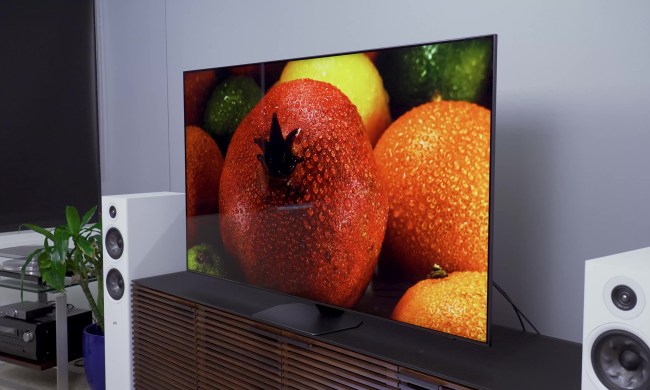We were among the first to cast an awkward eye at Samsung when the company decided to rebadge its premium 4K UHD TV line from SUHD to QLED. After all, QLED looks and sounds a lot like OLED — a competing TV technology Samsung once dabbled with, then strategically abandoned shortly thereafter. Now embarking on its second year of QLED branding, though, it seems apparent Samsung has a very clear vision for what QLED will be. It’s not just a souped-up version of mature LCD tech, nor is it just a name meant to confuse consumers who may be loosely familiar with OLED. QLED, as a brand, is as much about the user experience Samsung’s primo TVs bring to the table as the technology that powers it. And since we’ve seen up close for ourselves what Samsung’s 2018 QLED TVs can do, we’re inclined to cut the company some slack over nomenclature, and keep it focused on the performance and experience the products deliver.
Samsung’s philosophy puts picture quality first, without forgetting the crucial elements that can make or break a TV experience.
As part of our deep dive into what makes the recently announced QLED TVs stand out from the competition, we spoke with Samsung’s GM and SVP of Product Marketing, Dave Das, about what was new for QLED in 2018, what guided the company’s design philosophy, and why Samsung remains so bullish on developing LCD-based TV technology and avoiding OLED while reviewers (like us) gush un-apologetically over the many benefits of OLED TVs.
“The difference between 2018 QLED and 2017 QLED actually boils down to three big buckets. There’s the picture quality improvements … there’s, of course, the design element which has some really cool features we’re announcing today, and there’s the smart capability, which now really expands to encompass the multi-device experience,” Das explained.
Samsung’s philosophy puts picture quality first, without forgetting the crucial elements that can make or break a TV experience. After all, if a TV is a hassle to use or can’t connect to the device you need, does it matter that the picture quality is out-of-this-world good? In our experience, the answer to that question is no.
To that end, Samsung’s 2018 QLED TVs improve upon what made last year’s QLEDs so desirable. Specifically, they have made getting a QLED set up, connected to the internet, and logged into popular streaming apps as streamlined as possible. “The wonderful thing that Samsung has done is, number one, listen to our consumers … one of their big pain points is setting up their TV. Nobody likes to get a brand-new TV, plug it in — ready to watch — and then they have to spend 20 to 30 minutes keying in all of their passwords, get everything all set up, connect to their Wi-Fi — I mean, I can’t remember my Wi-Fi password. So, Samsung this year created an effortless login experience,” explains Das.
And it is pretty effortless. Those with Samsung phones or an Android or iOS device with Samsung’s Smart Things app will be alerted that a new TV has been detected, and will automatically log the TV into Wi-Fi using the phone’s credentials. From there, it will offer to log in any supported apps without the user having to punch in usernames and passwords for those apps — if the phone is already logged in, the TV will be too.
QLED TVs can monitor and control security cameras of many makes, smart thermostats, smart lights, and more.
If you have a smart home, Samsung wants these new TVs to sit at the center of it. Now that Samsung has folded all smart home device under one app, QLED TVs can monitor and control security cameras of many makes, smart thermostats, smart lights, and more.
On the picture quality front, QLED has implemented a few new technologies into the LCD panel which improve its performance in some historically weak areas. Specifically, a new anti-reflective layer helps mitigate “halo effect,” which is caused when a LED-backlit TV displays a bright object against a dark background. Samsung also made the choice to include full array local dimming (FALD) in its Q8F and Q9F top-tier TVs, for enthusiasts who crave the best possible contrast and maximum possible brightness for high dynamic range (HDR) performance.
While Samsung’s QLED TV line dazzled us in demos, as always we’ll reserve final judgment pending a rigorous in-house review process. We will be getting the Q8F and Q9F for review in late March or early April, and look forward to sharing more about how QLED fares against some stiff competition from LG, Sony, and TCL.
Be sure to watch our full interview above to hear more details, including why Samsung chooses to avoid OLED in favor of QLED.




